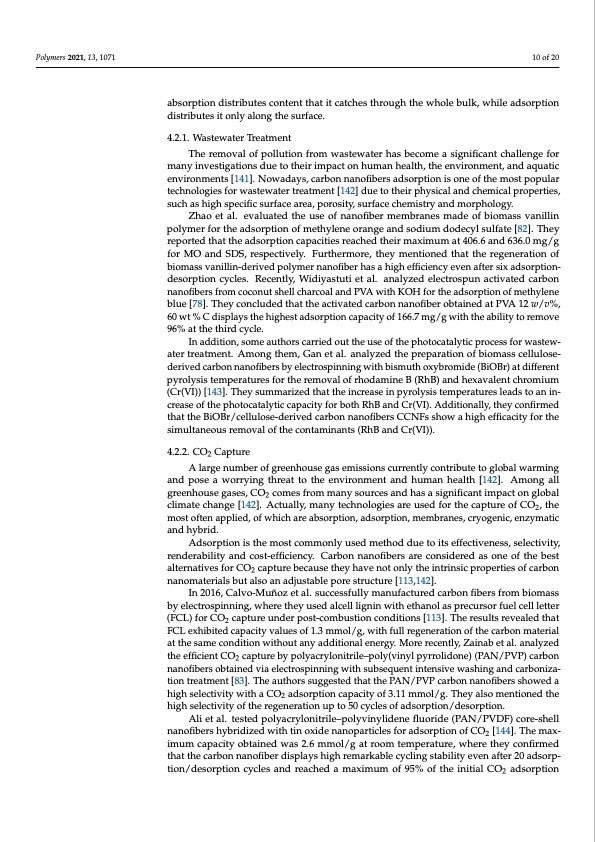
PDF Publication Title:
Text from PDF Page: 010
Polymers 2021, 13, 1071 10 of 20 absorption distributes content that it catches through the whole bulk, while adsorption distributes it only along the surface. 4.2.1. Wastewater Treatment The removal of pollution from wastewater has become a significant challenge for many investigations due to their impact on human health, the environment, and aquatic environments [141]. Nowadays, carbon nanofibers adsorption is one of the most popular technologies for wastewater treatment [142] due to their physical and chemical properties, such as high specific surface area, porosity, surface chemistry and morphology. Zhao et al. evaluated the use of nanofiber membranes made of biomass vanillin polymer for the adsorption of methylene orange and sodium dodecyl sulfate [82]. They reported that the adsorption capacities reached their maximum at 406.6 and 636.0 mg/g for MO and SDS, respectively. Furthermore, they mentioned that the regeneration of biomass vanillin-derived polymer nanofiber has a high efficiency even after six adsorption- desorption cycles. Recently, Widiyastuti et al. analyzed electrospun activated carbon nanofibers from coconut shell charcoal and PVA with KOH for the adsorption of methylene blue [78]. They concluded that the activated carbon nanofiber obtained at PVA 12 w/v%, 60 wt % C displays the highest adsorption capacity of 166.7 mg/g with the ability to remove 96% at the third cycle. In addition, some authors carried out the use of the photocatalytic process for wastew- ater treatment. Among them, Gan et al. analyzed the preparation of biomass cellulose- derived carbon nanofibers by electrospinning with bismuth oxybromide (BiOBr) at different pyrolysis temperatures for the removal of rhodamine B (RhB) and hexavalent chromium (Cr(VI)) [143]. They summarized that the increase in pyrolysis temperatures leads to an in- crease of the photocatalytic capacity for both RhB and Cr(VI). Additionally, they confirmed that the BiOBr/cellulose-derived carbon nanofibers CCNFs show a high efficacity for the simultaneous removal of the contaminants (RhB and Cr(VI)). 4.2.2. CO2 Capture A large number of greenhouse gas emissions currently contribute to global warming and pose a worrying threat to the environment and human health [142]. Among all greenhouse gases, CO2 comes from many sources and has a significant impact on global climate change [142]. Actually, many technologies are used for the capture of CO2, the most often applied, of which are absorption, adsorption, membranes, cryogenic, enzymatic and hybrid. Adsorption is the most commonly used method due to its effectiveness, selectivity, renderability and cost-efficiency. Carbon nanofibers are considered as one of the best alternatives for CO2 capture because they have not only the intrinsic properties of carbon nanomaterials but also an adjustable pore structure [113,142]. In 2016, Calvo-Muñoz et al. successfully manufactured carbon fibers from biomass by electrospinning, where they used alcell lignin with ethanol as precursor fuel cell letter (FCL) for CO2 capture under post-combustion conditions [113]. The results revealed that FCL exhibited capacity values of 1.3 mmol/g, with full regeneration of the carbon material at the same condition without any additional energy. More recently, Zainab et al. analyzed the efficient CO2 capture by polyacrylonitrile–poly(vinyl pyrrolidone) (PAN/PVP) carbon nanofibers obtained via electrospinning with subsequent intensive washing and carboniza- tion treatment [83]. The authors suggested that the PAN/PVP carbon nanofibers showed a high selectivity with a CO2 adsorption capacity of 3.11 mmol/g. They also mentioned the high selectivity of the regeneration up to 50 cycles of adsorption/desorption. Ali et al. tested polyacrylonitrile–polyvinylidene fluoride (PAN/PVDF) core-shell nanofibers hybridized with tin oxide nanoparticles for adsorption of CO2 [144]. The max- imum capacity obtained was 2.6 mmol/g at room temperature, where they confirmed that the carbon nanofiber displays high remarkable cycling stability even after 20 adsorp- tion/desorption cycles and reached a maximum of 95% of the initial CO2 adsorptionPDF Image | Electrospun Carbon Nanofibers from Biomass and Biomass Blends

PDF Search Title:
Electrospun Carbon Nanofibers from Biomass and Biomass BlendsOriginal File Name Searched:
88145ac687f0c36c7096f236fabe2cba856c.pdfDIY PDF Search: Google It | Yahoo | Bing
Sulfur Deposition on Carbon Nanofibers using Supercritical CO2 Sulfur Deposition on Carbon Nanofibers using Supercritical CO2. Gamma sulfur also known as mother of pearl sulfur and nacreous sulfur... More Info
CO2 Organic Rankine Cycle Experimenter Platform The supercritical CO2 phase change system is both a heat pump and organic rankine cycle which can be used for those purposes and as a supercritical extractor for advanced subcritical and supercritical extraction technology. Uses include producing nanoparticles, precious metal CO2 extraction, lithium battery recycling, and other applications... More Info
| CONTACT TEL: 608-238-6001 Email: greg@infinityturbine.com | RSS | AMP |